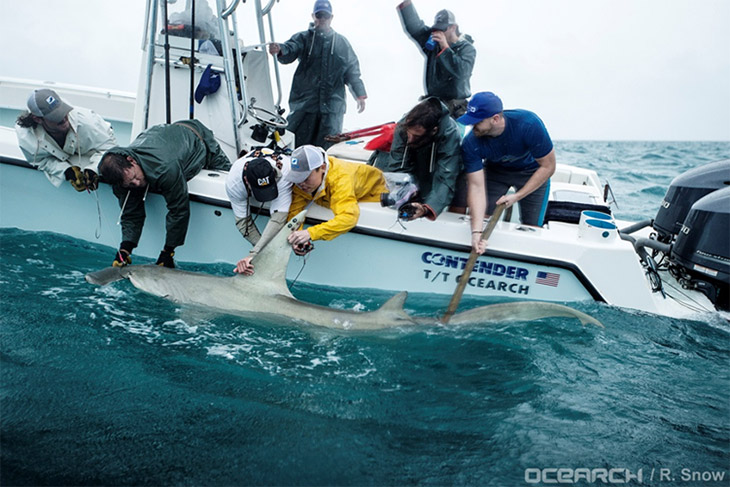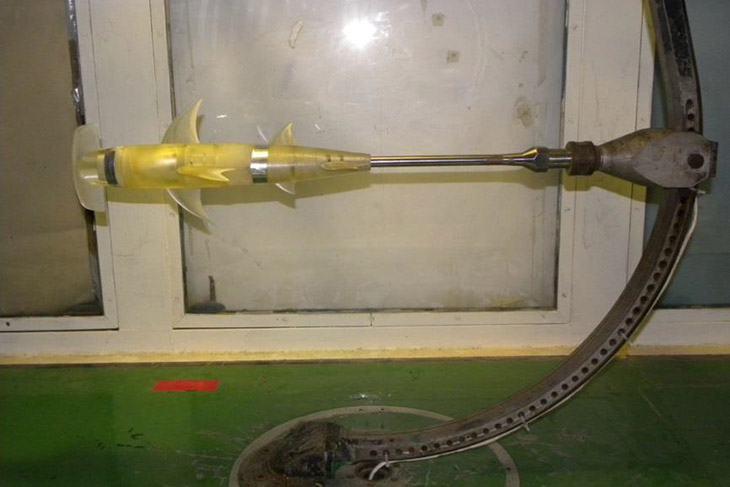National Institute of Polar Research
[Research Highlight] Great hammerhead sharks swim on their sides to reduce energy expenditure
Released on July 29, 2016 (in Japanese)
Posted on October 13, 2016
National Institute of Polar Research
This study revealed that great hammerhead sharks (Sphyrna mokarran) swim on their sides at roll angles of approximately 60°. This helps them to avoid sinking and minimizes their energy expenditure while swimming.
Dr. Yuuki Watanabe, an associate professor at the National Institute of Polar Research, Japan, and his international colleagues discovered that great hammerhead sharks (Sphyrna mokarran) swim on their sides at roll angles of approximately 60°. The sharks, which were fitted with multi-sensor electronic tags, alternated between rolling to the left and right sides every 5–10 min. However, it was unknown why they exhibit such a strange swimming style. To find out, the team built a morphologically accurate model of a hammerhead shark and conducted a series of fluid dynamic experiments. They found that when the sharks rolled, their unusually long dorsal fins effectively produced lift forces, much like airplane wings do, allowing them to avoid sinking and continue swimming at minimum energy expenditure. Thus, great hammerhead sharks have developed a unique morphology and swimming style to reduce the energetic costs of swimming.

Figure1: A wild great hammerhead shark being tagged by the researchers at the Great Barrier Reef, Australia. Photo: R. Snow
Credit: NIPR, Photo by R. Snow
Movie 1: This movie was recorded using a video camera attached to a shark’s dorsal fin. It shows the shark alternating between rolling to the right and left sides.
Credit: NIPR

Figure2: A shark model in a wind tunnel.
Published Paper
Nicholas L. Payne1,2, Gil Iosilevskii3, Adam Barnett4, Chris Fischer5, Rachel T. Graham6, Adrian C. Gleiss7 & Yuuki Y. Watanabe1,8
1 National Institute of Polar Research, Japan
2 Department of Life Sciences, University of Roehampton, UK
3 Faculty of Aerospace Engineering, Technion, Israel
4 College of Marine and Environmental Sciences, James Cook University, Australia
5 Ocearch, Park City, USA
6 MarAlliance, Belize
7 School of Veterinary and Life Sciences, Centre for Fish and Fisheries Research, Murdoch University, Australia
8 SOKENDAI (The Graduate University for Advanced Studies), Japan
Great hammerhead sharks swim on their side to reduce transport costs.
Nature Communications. 7:12289 (2016)
doi: 10.1038/ncomms12289
URL: http://www.nature.com/ncomms/2016/160726/ncomms12289/full/ncomms12289.html
Published online: July 26, 2016
Acknowledgement
This study was supported by Grant-in-Aid for Scientific Research (No. 25850138 and No. 16H04973) from the Japan Society for the Promotion of Science.
Contact
Public Relations Section, National Institute of Polar Research
E-mail: kofositu@nipr.ac.jp








